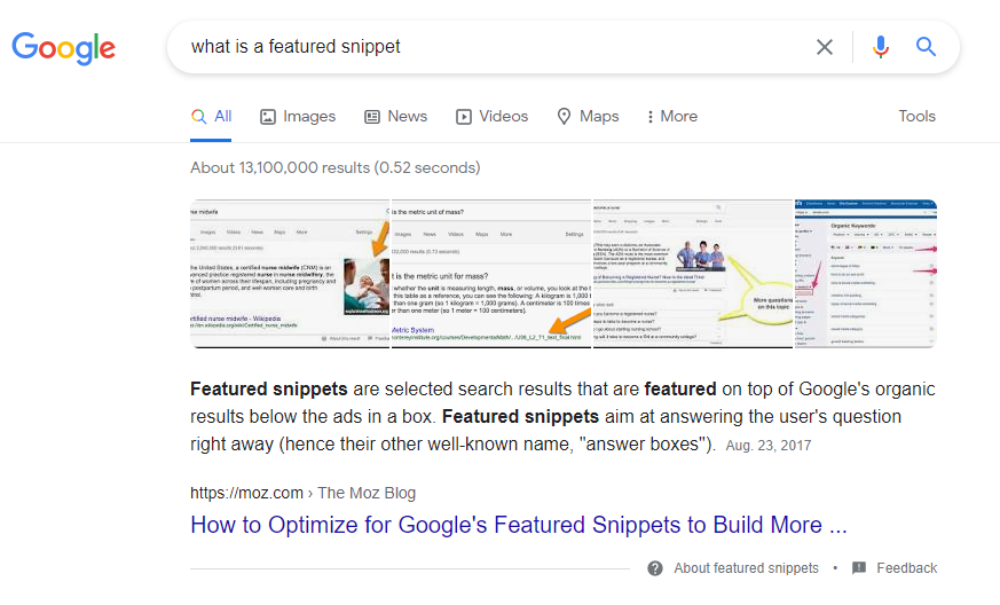Here’s the skinny on Google Snippets
Appearing in a Google Snippet is a coveted position on the SERP, but is there a sure-fire way to get there?

If you work with SEO, you probably already know the importance of appearing in a high position on the search engine results page, or SERP, especially on Google.
As the undisputed market leader, Google held a whopping 87.76 percent of the market share for search engines as of June 2021, a dramatic advantage over Bing’s and Yahoo’s share of 5.56 percent and 2.71 percent, respectively.
Google’s algorithm is continually changing to provide searchers with accurate and relevant results. The search engine also introduces new features periodically to provide information and answers faster with fewer clicks.
One of these features is Featured Snippets, special rich callout boxes that provide additional information from Google’s Knowledge Graph to answer the user’s query quickly, unlike standard SERP results which you must click to go to a separate web page.
Every business with a digital presence should strive to have their pages featured in Snippets, but is there a roadmap to getting there? Technically, no, but the full answer is a bit more complicated.
More answers, less clicking
Results in a Google Snippet appear at the very top of the search engine results page. They can take on a few different forms, including lists, paragraph descriptions, tables and videos, depending on the information being conveyed.
For example, if you search for “chicken alfredo,” you might see a list of steps to prepare that dish or an image carousel of web pages featuring the recipe.
“The benefit for searchers is that it provides the information they're looking for quickly without having to visit the website itself for answers,” says Brandon Gilmore, SEO Manager at Motum B2B. “For businesses, it allows them to be near or at the top of the search results, which can help drive traffic, brand awareness and organic growth.”
Having a page featured in a Snippet can have a positive impact on impressions and clicks, ultimately leading to a potential increase in important KPIs such as leads, web traffic or brand awareness.
Although certain types of Google Snippets are more relevant for consumer-facing products and services, there’s plenty of useful opportunities for B2B organizations to leverage them as well.
In the B2B world, Snippets are great for conveying technical information and useful industry knowledge in paragraph form to searchers using highly specific search queries, such as “best industrial-strength vacuums” or “chemical compounds in a hydrophobic paint coating.”

Do they work?
Just how effective are Google Snippets? One study found that the click-through rate on a featured page increased from 2 percent to 8 percent when it was featured in a Snippet, with revenue from organic traffic increasing by 677 percent.
Sometimes Snippets can cause an overall decrease in clicks on a SERP, because if users find what they’re looking for, there’s no need to click any results.
At this point you may be thinking, “Hey, don’t we want searchers to click our links instead of seeing the answer on Google and leaving?” Gilmore says that’s not necessarily the case.
“Having a page in a Featured Snippet is referred to as ‘position zero,’” he says. “The benefit doesn't just lie in the form of web traffic. The benefit comes from informing users and raising brand awareness, because ultimately you may or may not get the click at all even if you’re in the Featured Snippet.”
Finally, being featured in a Google Snippet conveys brand authenticity because it stands out from other “regular” results, boosting brand reputation and directly meeting your audience’s needs.

How can I be featured in one?
Here’s where it gets tricky. There’s no sure-fire way to get your page featured in a Snippet. It can’t be purchased or programmed, but there are several SEO and content best practices you can follow to increase your chances of having a web page featured.
“It’s unknown exactly how the algorithm works for featured Snippets and why it pulls the content it does,” says Gilmore. “Generally, it’s believed that you should lay out page content so that it states the question and answers the question in a way that’s easily read by users and bots.”
Other best practices to encourage Snippet inclusion include optimizing content, using question keywords, analyzing competitors and understanding user intent.
“It all comes down to having content that’s well laid out and structured. You also need to have the authority to be able to show up in the featured snippet, which can come through the form of backlinks, inbound links, and many other ways to drive authority to your website’s content,” says Gilmore.
If you’d prefer your page not to be featured in a Snippet, you can use “nosnippet” tags in the web code so Google knows not to feature that page in a Snippet.
Can B2B agencies help with Snippets?
At the end of the day, the best way to have your page featured on a Snippet is to ensure your web page is checking all the right boxes for Google’s algorithm regarding SEO. It also means making sure you’ve got talented copywriters using their wordsmithing skills to deliver the right answers to your audience.
“It's a combination of research, content writing and optimization,” says Gilmore. “The content team crafts great content, and then the SEO team comes in and tags it with the appropriate schema to promote Snippet creation. The best content is usually always featured in the Snippet.”
“Ultimately, keep in mind that the featured Snippet itself is dynamically produced by the algorithms that scrape and read content, and then seeing if it answers the question or the intent of the search.”
Even if you’ve followed all the best practices and wrote great content, your page may still not show up as a Featured Snippet, but don’t be discouraged. The algorithm is always changing, and improving SEO and content will always put your page in a more favourable position.
Want your web page featured in a Snippet, or just looking to up your SEO and content game? Get in Touch.